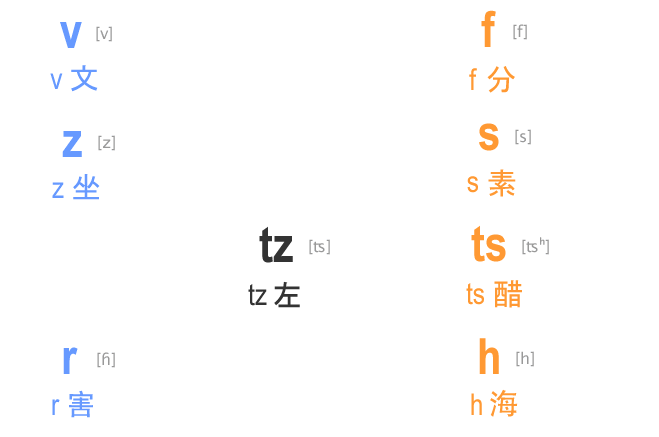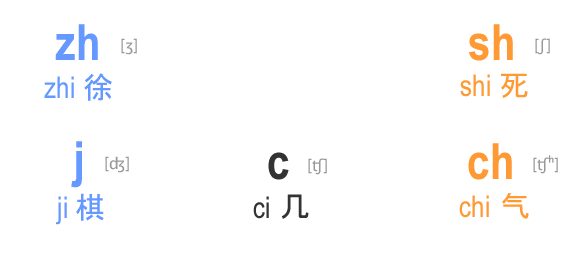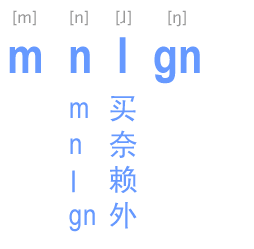| Main | Introduction | Resources | Community | Shanghainese Dialogue | Other Resources |
| - News | - Background | - Pronunciation Drills | - BBS Forums | - Lesson Guide | - Articles |
| - About Us | - Consonants & Initials | - Hanzi Pronunciation | - Experimentation | - Lesson 1 | - Grammar |
| - Citations | - Vowels & Finals | - Romanizations | - Listen | - Lesson 2 | - Other Wu Dialects |
| - Tones & Accent | - Vocabulary List | - Shanghainese Culture | - Lesson 3 | - Wu Literature |
| - FAQ | - Dictionary | - more... | - Links |
INTRODUCTION
Pronunciation (Part 1 - Consonants, Basic version)
Wu Chinese phonology (including Shanghainese) is quite different from Mandarin and Cantonese. In comparison with foreign languages, Shanghainese vowels are most similar to French and German; while the consonants are similar to French and English. The phonology presented below is that of the widely perceived modern standard for Shanghainese (Middle Shanghainese, or Standard Shanghainese), with speakers between 20 to 60 years of age. New (Youth) Shanghainese is nearly identical to Standard Shanghainese, except it has merged a few vowels together (which will be explained in the Vowel section).
INITIAL CONSONANTS:
Plosives

Shanghainese has three types of plosives: voiced, voiceless unaspirated, and voiceless aspirated.
Being able to distinguish the three types is critical for comprehension. Mandarin and Cantonese do not have voiced consonants; speakers of these languages should not confuse the voiceless unaspirated consonants with the voiced consonants in Shanghainese. Voiced consonants require you to vibrate your vocal cords (and lips) as you pronounce the consonant.
Fricatives and Affricates

Fricatives:
Fricative and Affricate Palatals

Palatals can be both postalveolar or alveolo-palatal (postalveolar is far more common).
Fricative palatals:
Sonorants

Sonorants naturally are all voiced.
Nasals:
Zero initial
Zero initials are vowels (a, e, i, o, u) and are usually realized with a glottal stop.
CONSONANT FINALS:
Excluding the syllabic continuants, Shanghainese has only 2 consonant endings.
1. The Nasal

There is only one nasal final in Shanghainese (while Mandarin has two: -n, -ng). The nasal final is represented by n, and can be phonetically palatal after i and e, velar after o and a part of the nasal vowel after a and aa (all are allophones). There is no distinction for speakers.
2. The Glottal Stop
The glottal stop is not directly marked on the romanization although it is implied by the letter "e" at the end of a syllable. It is the plosive sound made after "uh" when pronouncing "uh oh" in English. The glottal stop is not actually pronounced during most of normal conversation, and since it always follows a short vowel, the time duration of a syllable with a glottal stop final is about half of a long syllable. The full glottal stop exists only when a syllable is pronounced in isolation and with emphasis. Rhymes e, ie, ae, iae, uae, oe, ioe, yue are all short and would contain a glottal stop. There is no Mandarin equivalent; Mandarin does not have Rusheng. More information in the next section.
SONORANT SYLLABIC CONTINUANTS:
Shanghainese has 3 nasal (m, n, ng) syllabic continuants and one rhotic continuant (r/l). See the next section for examples.

INITIAL CONSONANTS:
Plosives

Shanghainese has three types of plosives: voiced, voiceless unaspirated, and voiceless aspirated.
Being able to distinguish the three types is critical for comprehension. Mandarin and Cantonese do not have voiced consonants; speakers of these languages should not confuse the voiceless unaspirated consonants with the voiced consonants in Shanghainese. Voiced consonants require you to vibrate your vocal cords (and lips) as you pronounce the consonant.
- The lenis voiced plosives b, d, g in Shanghainese are equivalent to English b (boy), d (dog) and g (girl). No Mandarin equivalent.
- The fortis voiceless unaspirated plosives p, t, k in Shanghainese are equivalent to the French p (peu), t (temps) and k (kilo) or c (Cannes). They are also equivalent to the English p, t, k when following "s", such as spy, sky and sty.
- The fortis voiceless aspirated plosives ph, th, kh in Shanghainese are equivalent to the English p (pencil), t (toad) and k (kite). They are also equivalent to the Mandarin Hanyu Pinyin p, t, k. Do not pronounce the ph as an f.
Fricatives and Affricates

Fricatives:
- Voiced fricatives v, z are equivalent to the English v (viper) and z (zoo). Again, no Mandarin equivalent (Mandarin does not have voiced consonants).
- Voiceless fricatives f, s are equivalent to the English f (fiber) and s (Suzy). The Shanghainese s is somewhat different from the Mandarin Hanyu Pinyin s; the Shanghainese is normal and alveolar like in English, while the Mandarin is dental (which is quite unique).
- Voiced glottal fricative r is similar to the Dutch g and French r. It is somewhat breathy in quality. Do not pronounce like English or Mandarin r.
- Voiceless glottal fricative h is equivalent to the English h (high) and distinctively different from the Mandarin Hanyu Pinyin h /x/ (害 hai4).
- The alveolar voiceless unaspirated affricate tz is similar to the Mandarin Hanyu Pinyin z (再 zai4). It is also similar to the Japanese ts ツ (普通 futsuu). There is no English equivalent; the sound can be approximated by pronouncing a voiceless "ds" (seeds), try to pronounce very quickly "eat ds" (the same ds in seeds).
- The alveolar voiceless aspirated affricate ts is identical to the German z (zu, Zeiss) or ts (abseits). It is also similar to the English -ts finals (sheets) and the Mandarin Hanyu Pinyin c (菜 cai4).
Fricative and Affricate Palatals

Palatals can be both postalveolar or alveolo-palatal (postalveolar is far more common).
Fricative palatals:
- Voiced fricative palatal zh is identical to the "zh" in the English pronunciation of "Doctor Zhivago". It is also identical to the French j (Jacques) and the English s in measure. No Mandarin equivalent.
- Voiceless fricative palatal sh is identical to the Japanese sh シ (死ぬ shinu) and similar to the Mandarin Hanyu Pinyin x (系 xi4) and the English sh (she).
- Voiced affricate palatal j is identical to the English j (Jack) or the "soft" English g (George, ginger); it is also identical with the Japanese j ジ (十 juu). No Mandarin equivalent.
- Voiceless unaspirated affricate palatal c is very similar to the Mandarin Hanyu Pinyin j (几 ji3). There is no English equivalent; the sound can be approximated by pronouncing the ch in cheese with smaller gap between the teeth.
- Voiceless aspirated affricate palatal ch is usually identical to the English "soft" ch as in cheese or Charles.
Sonorants

Sonorants naturally are all voiced.
Nasals:
- Bilabial nasal m is equivalent to the English m (mom).
- Alveolar nasal n is equivalent to the English n (no).
- Velar nasal gn is equivalent to the English ng ending as in king and the nasal g が行 in Japanese. It is spelled gn (similar to Classical Latin gn for /ng n/) instead of ng to remove ambiguities in syllable parsing when following an open syllable. Many native speakers cannot differentiate the gn with n, hence also its reversed spelling as English n and gn (gnome) are identical in pronunciation.
- The alveolar lateral flap l is very similar to the Japanese r ら行 (六 roku). The only difference is that in the Shanghainese, it is lateral, meaning air comes out from the sides of the mouth as in the English l. In both the Shanghainese and the Japanese there is, however, a brief flapping of the tip of the tongue to the hard plate roof of the mouth. Pronouncing the Shanghainese l as an English l will not change comprehension in anyway, as there is no r/l distinction.
Zero initial
Zero initials are vowels (a, e, i, o, u) and are usually realized with a glottal stop.
CONSONANT FINALS:
Excluding the syllabic continuants, Shanghainese has only 2 consonant endings.
1. The Nasal

There is only one nasal final in Shanghainese (while Mandarin has two: -n, -ng). The nasal final is represented by n, and can be phonetically palatal after i and e, velar after o and a part of the nasal vowel after a and aa (all are allophones). There is no distinction for speakers.
2. The Glottal Stop
The glottal stop is not directly marked on the romanization although it is implied by the letter "e" at the end of a syllable. It is the plosive sound made after "uh" when pronouncing "uh oh" in English. The glottal stop is not actually pronounced during most of normal conversation, and since it always follows a short vowel, the time duration of a syllable with a glottal stop final is about half of a long syllable. The full glottal stop exists only when a syllable is pronounced in isolation and with emphasis. Rhymes e, ie, ae, iae, uae, oe, ioe, yue are all short and would contain a glottal stop. There is no Mandarin equivalent; Mandarin does not have Rusheng. More information in the next section.
SONORANT SYLLABIC CONTINUANTS:
Shanghainese has 3 nasal (m, n, ng) syllabic continuants and one rhotic continuant (r/l). See the next section for examples.
Next: Vowels and Rhymes
Back to top.